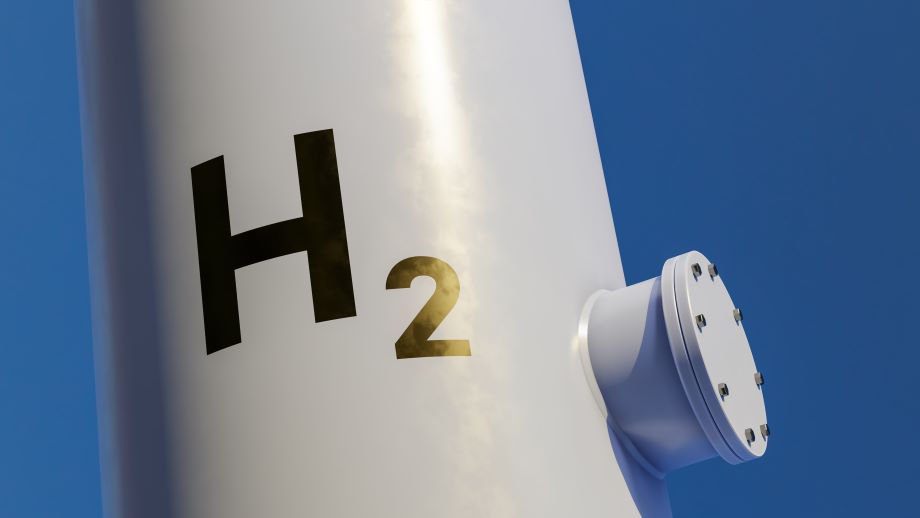Nanopores for Hydrogen Storage Breakthrough
Nanopores for Hydrogen Storage Breakthrough


A magnesium borohydride structure can store hydrogen at more than double the capacity of traditional methods.
Hydrogen has great promise as a fuel in personal and public transport vehicles, but applications have been hindered by problems with storage. Large-scale storage of hydrogen is difficult because of its weak intermolecular interactions. Present-day storage methods mainly utilize molecular hydrogen storage in either gaseous or liquid phases—however, these have pressure and temperature conditions that limit capacity.
While scientists have started to investigate nanoporous chemical materials as an option for gas storage, achieving high volumetric storage capacity is still a problem—until now.
Researchers at Ulsan National Institute of Science and Technology (UNIST) in the Republic of Korea recently announced they have formulated a unique magnesium borohydride structure that can store up to 144 g/L of hydrogen per volume of pores, more than double the capacity of traditional methods, such as storing hydrogen as a gas in a liquid state.
These promising results may lead to the development of high-capacity hydrogen storage systems for critical automotive and transportation applications.
overcame the challenge of low hydrogen storage capacity by leveraging advanced high-density adsorption technology using magnesium borohydride (Mg(BH4)2), a material the team synthesized. The compound’s framework has nanoscale pores and a partially negatively charged non-flat interior for hydrogen uptake.
Oh’s team used several protocols to test the physical and chemical properties of its new nanoporous material, magnesium borohydride structure. It used neutron powder diffraction for determining the position of hydrogen atoms in the framework structure and the adsorption sites of the molecules and volumetric gas adsorption to further verify the presence of two hydrogen adsorption sites and to characterize their thermodynamics. In addition, the team employed spectroscopic characterization and periodic density functional simulations to measure material properties.
These various analytical techniques allowed the team to precisely determine the molecular locations and understand and verify how such a large quantity of hydrogen can exist within the nanoscale pores.
Discover the Benefits of ASME Membership
Oh’s tests showed that molecular hydrogen is packed extremely densely within the magnesium borohydride. “We found a penta-dihydrogen cluster where H2 molecules in one position have rotational freedom, whereas H2 molecules in another position have a well-defined orientation and a directional interaction with the framework,” Oh said.
The synthesized nanoporous complex hydride consisting of magnesium hydride, solid boron hydride (BH4)2, and magnesium cation (Mg+), can store five hydrogen molecules in a three-dimensional arrangement, achieving unprecedented high-density hydrogen storage. In fact, the high density of hydrogen molecules within the material exceeds that of the solid state, highlighting the efficiency of this novel storage approach.
Take the Quiz: How Much Do You Know About Energy Fuel of the Future?
"Our developed material has the potential to safely and efficiently store a significant amount of hydrogen, surpassing conventional hydrogen storage methods,” Oh said. “This is a significant step toward addressing the hydrogen storage challenge, a critical hurdle in the widespread adoption of hydrogen fuel for public transportation, and enhancing the efficiency and economic feasibility of hydrogen energy utilization."
Mark Crawford is a technology writer in Corrales, N.M.
While scientists have started to investigate nanoporous chemical materials as an option for gas storage, achieving high volumetric storage capacity is still a problem—until now.
Researchers at Ulsan National Institute of Science and Technology (UNIST) in the Republic of Korea recently announced they have formulated a unique magnesium borohydride structure that can store up to 144 g/L of hydrogen per volume of pores, more than double the capacity of traditional methods, such as storing hydrogen as a gas in a liquid state.
These promising results may lead to the development of high-capacity hydrogen storage systems for critical automotive and transportation applications.
Nanopores are a perfect fit
The UNIST research team, led by associate professor of chemistry Hyunchul Oh,overcame the challenge of low hydrogen storage capacity by leveraging advanced high-density adsorption technology using magnesium borohydride (Mg(BH4)2), a material the team synthesized. The compound’s framework has nanoscale pores and a partially negatively charged non-flat interior for hydrogen uptake.
Oh’s team used several protocols to test the physical and chemical properties of its new nanoporous material, magnesium borohydride structure. It used neutron powder diffraction for determining the position of hydrogen atoms in the framework structure and the adsorption sites of the molecules and volumetric gas adsorption to further verify the presence of two hydrogen adsorption sites and to characterize their thermodynamics. In addition, the team employed spectroscopic characterization and periodic density functional simulations to measure material properties.
These various analytical techniques allowed the team to precisely determine the molecular locations and understand and verify how such a large quantity of hydrogen can exist within the nanoscale pores.
Discover the Benefits of ASME Membership
Oh’s tests showed that molecular hydrogen is packed extremely densely within the magnesium borohydride. “We found a penta-dihydrogen cluster where H2 molecules in one position have rotational freedom, whereas H2 molecules in another position have a well-defined orientation and a directional interaction with the framework,” Oh said.
The synthesized nanoporous complex hydride consisting of magnesium hydride, solid boron hydride (BH4)2, and magnesium cation (Mg+), can store five hydrogen molecules in a three-dimensional arrangement, achieving unprecedented high-density hydrogen storage. In fact, the high density of hydrogen molecules within the material exceeds that of the solid state, highlighting the efficiency of this novel storage approach.
Moving forward
This groundbreaking development in efficient, high-capacity hydrogen storage marks an important advancement for future energy systems. The nanoporous magnesium borohydride structure can store hydrogen at high densities, even under normal atmospheric pressure.Take the Quiz: How Much Do You Know About Energy Fuel of the Future?
"Our developed material has the potential to safely and efficiently store a significant amount of hydrogen, surpassing conventional hydrogen storage methods,” Oh said. “This is a significant step toward addressing the hydrogen storage challenge, a critical hurdle in the widespread adoption of hydrogen fuel for public transportation, and enhancing the efficiency and economic feasibility of hydrogen energy utilization."
Mark Crawford is a technology writer in Corrales, N.M.



.png?width=854&height=480&ext=.png)
